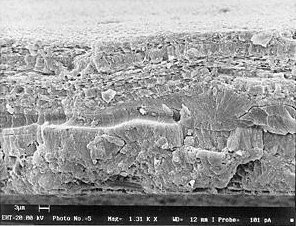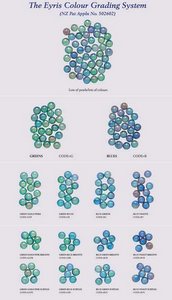|
Blue Pearl 5
|
 Fig. 18. SEM photomicrograph of the thin, even layers of aragonitic nacre that are found on an Eyris Pearl ™ |
The thickness of each succeeding layer of conchyolin and nacre, and the pattern in which they are laid down, is dependent on such factors as the genetic makeup and health of the individual abalone, its food (seaweed) and the environment in which the pearl has been cultivated.
GRADING
Eyris Pearls™ are graded for sale into categories of Gem, A and B grade by an exacting process that involves detailed consideration of a pearl's color, surface and luster. Shape and dimension have no influence on the assigned grade. Detailed criteria for quantifying lustre (into categories of mirror, reflective and soft), surface (into categories of smooth, visible, and textured), and colour (into categories of green gold pink brights or subtles, green blue brights or subtles, blue green brights or subtles, blue violet brights or subtles) have been published in print and electronically (at bluepearls.com) as The Eyris Pearl Grading System.
According to the published grading system:
Gem grade pearls must be eye-catching; it must have ‘the look’. A gem quality pearl must have vibrant colour, iridescence, good character, no obvious faults, no scratches, and no surface imperfections that detract from the quality of the pearl. It must have great lustre and a smooth surface.
A grade pearls must have a mostly smooth surface and be of good quality with good lustre and few obvious faults. Any imperfections must be slight and not detract from the attractiveness of the pearl. The pearl must have good colour, iridescence and character.
B grade pearls, although still good useable pearls, do not display the same characteristics as 'Gem' and A grade pearls. The surface of a 'B' grade pearl is mostly not smooth and can be visibly textured, while the lustre of the B grade pearl can range from mirror to soft. There may be some surface roughness and the color may not be as vibrant or eye-catching as 'Gem' or 'A' grade pearls.
C grade pearls are those that fall below the three standards set above. They may be reject pearls or marketed as Pacific Blue Pearls. A marketable 'C' grade pearl may have major faults and will require the use of innovative jewellery setting. Generally they will lack character and it will be easy to see why they do not make the grade.
Interested gemmologists should consult The Eyris Blue Pearl™ Grading System to become competent in the use of this grading system.
THE LAST STAGE IN THE PROCESS
As the last stage in producing this attractive cultured abalone half pearl, the pearl’s history is stored in a computer system that creates a unique identification system for each pearl. What is recorded and available to a future customer on a once only basis is information about: who was the diver who fished the "mother" abalone; the date and area where the abalone was harvested from the ‘wild’; and the size and quality of the pearl that was recovered from the shell. This unique identity is passed onto each customer, via the special certificate that is issued with every Eyris Blue Pearl™ sold. Simply put, if the pearl doesn’t have this certificate, then it is not an authentic Eyris Blue Pearl™
Acknowledgements: The author wishes to thank Roger Beattie and Shirley Went of Eyris Blue Pearls™, Murray Brereton of Akaroa Blue Pearls, and various State and Commonwealth Departments
Websites consulted:
Address for correspondent:
Pam Hutchins
P.O. Box 298
Bundaberg Q 4670
Australia

Abalone Luster
Smooth Visible Textured

Abalone Luster
Mirror Reflective Smooth

Abalone Pearl Color
First Parts of Pam Hutchins' Article
Back to Part 1
Back to Part 2
Back to Part 3
Back to Part 4.
Read more about Abalone pearls after Blue Pearl 5.






